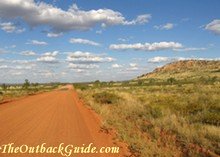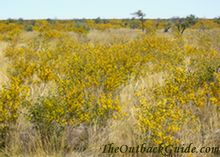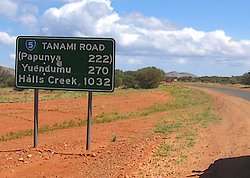The Tanami Desert, Australia
The Tanami Desert

Size And Location
Climate
Environment
Travel (The Tanami Track)
If you search for information about the Tanami Desert on the internet you find that most websites regurgitate the same - incorrect - information.
The Tanami is called "one of the most isolated and arid places on earth" or something along those lines. - "As far from the beaten track as possible." - "Strictly for experienced four wheel drivers only." This might have been true ten years ago, but it certainly isn't today...
On this page you'll find information on the size, location, climate and environment of the Tanami Desert.
And at the bottom, under the heading "Travel", I also tell you everything you need to know if you want to cross the Tanami Desert along the Tanami Road (more commonly known as the Tanami Track).

This is a trip that anyone with a reasonable measure of common sense and a reliable car (any car!) can do.
By the way, the Stuart Highway also crosses part of the Tanami, and technically the famous Devils Marbles near Tennant Creek are located in the Tanami as well. So are the Murchinson and Davenport Ranges to the east of the highway.
Size And Location
At 184,500 km2 (71,235 square miles) the Tanami Desert is Australia's third largest desert.
Those figures are from the Australian Department of Environment and Heritage. The Tanami page of Wikipedia has it at about a quarter of that... (Goes to show that, while certainly a great resource, Wikipedia isn't always a reliable source of information. At least they show the right figures on their "Deserts of Australia" page.)
The Tanami Desert is located north west of Alice Springs, in the Northern Territory of Australia, to the east of the Great Sandy Desert.
The Tanami Track - which traverses the desert - starts only a few kilometres north of Alice Springs and takes you north west from there, across the border into Western Australia (and a bit into the Great Sandy Desert), to Halls Creek in the Kimberley.
The Tanami is the northernmost desert in Australia. Now, the further north you go in Australia, the more tropical the climate becomes, and the more rain you get...
Climate And Weather
The average annual rainfall in the Tanami Desert is over 400 mm! That is a lot of rain. But the Tanami's location in the north also means high temperatures, and with that a high evaporation rate. So it still is pretty dry.
Rain falls in "summer", during the wet season in the tropical regions, and when it rains it pours. So much so that the Tanami Track is often impassable during that time of the year. Yes, because it floods.
During summer (Oct - Mar) the average maximum day time temperatures hover around 36 - 38°C (97 - 100F), dropping at night to 20 - 22°C (68 - 71F). (Note that I said average maximum. The temperatures can soar above 45°C/115F!)
Winters are much cooler. At the coldest time of the year (June/July) day time temperatures are only about 25°C (77F), and the night time temperatures drop below 10°C (50F). Again, these temperatures are averages. Between May and August you may very well get night frosts!
Environment, Flora And Fauna
Here are some photos I took last time I crossed this "extremely inhospitable region"...


As you can see in the pictures, the country consists mostly of sandy plains. A lot of it is covered in spinifex grass, low acacias (the yellow flowering shrubs), some spindly grevilleas and other small trees, and lots of termite hills.
In the southern parts you have some low ranges, in the middle it gets noticeably flatter, and as you near the Kimberley the terrain changes again and becomes rocky and hilly.
The Tanami Desert even includes some wetland areas: Lake Surprise in the Northern Territory, and Lake Gregory in Western Australia. Lake Gregory actually retains permanent surface water (lakes in deserts are usually nothing but salt flats), the only lake in this area or the deserts to the south to do so. "Most arid place on earth", yeah, right...
The Tanami Desert is a very important biological area in Australia, and is a refuge for many endangered species, both plants and wildlife. The best known were the rufous hare-wallaby (mala), the bilby and the mulgara. In the nineties these species were still fairly common in the Tanami Desert, more than anywhere else in Australia.
Unfortunately increasing pressure from feral invaders and habitat degradation has changed that. Cats, some foxes and rabbits, camels and donkeys all do plenty of damage. So does fire and overgrazing by cattle (there is some cattle farming in the Tanami Desert), a very, very common problem in Outback Australia.
Travel - The Tanami Track

The Tanami Road is also referred to as the McGuire Road / Track, but is most commonly known as the Tanami Track.
It has a reputation as a serious four wheel drive adventure into terribly remote and harsh country. That's, uh, nonsense. It's a perfectly good road that you can take on even in conventional vehicles, provided it is dry and you are reasonably prepared.
The main reason that the Tanami Road is now in such good condition is that the mining industry in the area has picked up again. The Tanami and Granites mines, just off the main road, are amongst the biggest gold mines in Australia. The Tanami Road is their major service route, and that's good for anybody else who wants to use it...
But there aren't many services along the Tanami Track. When I say you need to be reasonably prepared I mainly mean that you should have a reliable car and a couple of good spare tyres. The only other essential is a reasonable measure of common sense.
Unless you have a long range tank you will also need to carry some spare fuel, and - and I shouldn't need to say that - of course you should always carry plenty of water. Most of the bore water available along the route is unsuitable for drinking.
(Do I need to tell you that you need to take food if you want to eat along the way?)
The Tanami Track starts only 20 km north of Alice Springs. The whole length of it to Halls Creek in the Western Australia Kimberley is a bit over 1050 km. (Different sources will give you slightly different numbers here.)
The trip takes about two days.
There are several points along the way where you can buy fuel and limited supplies (if you are lucky you might even get someone to do some mechanical repairs) but not all those places are reliable. Tilmouth Well and Rabbit Flat Roadhouse are.
Their respective distance from Alice Springs / Halls Creek is:
Tilmouth Well: 206 km from AS / 869 km from HC
Rabbit Flat: 622 km from AS / 453 km from HC
Rabbit Flat used to be closed Tue - Thu (and you still find that information just about everywhere). But they are now open 7 days a week! (If you need to rely on them for re-fuelling better ring them first to make sure they didn't change that again. Their phone number is 08 8956 8744). Tilmouth Well is open 7 days a week.
Update: Please note the Rabbit Flat closed for good on December 31, 2010.
Most of the Tanami Desert is Aboriginal land, belonging to the Warlpiri people. You don't need a permit, though, as long as you don't leave the main track and only drive into communities to buy fuel or supplies. If you want to venture elsewhere you have to get a permit first. You also need permission to enter private land (cattle stations) or any of the mine sites.
There isn't much along the way in terms of big sights or attractions. The Tanami Track is mostly used as a short cut between central Australia and the Kimberley. But I find the drive and the country itself more than attractive enough. I would drive it even if it was a detour... It certainly is a nice alternative to the Stuart Highway if you already know that section of the highway.
More details about the Tanami Track, including details and pictures of my last trip, are coming soon.
Related reader pages:
Tanami Track 2011 onwards
Next year I'm driving from Newcastle to Broome going via the Tanami Track (Rd). I understand that the Rabbit Flat Roadhouse is closing down at the end of...
Camping In The Tanami Desert
I read conflicting info about camping in the Tanami Desert. Your site seems to be better balanced and sensible. Our family will be driving across the Tanami ...
Working in the Tanami
I once worked as a field assistant in the Killi Killi hills B, not too far from Giles weather station run by a young couple those years. We were doing ...
Read about other Australian Deserts
Read more about the Australian Outback
Return from Tanami Desert to Outback Australia Travel Guide home page





